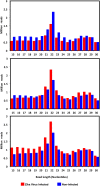Zika virus alters the microRNA expression profile and elicits an RNAi response in Aedes aegypti mosquitoes
- PMID: 28715413
- PMCID: PMC5531668
- DOI: 10.1371/journal.pntd.0005760
Zika virus alters the microRNA expression profile and elicits an RNAi response in Aedes aegypti mosquitoes
Abstract
Zika virus (ZIKV), a flavivirus transmitted primarily by Aedes aegypti, has recently spread globally in an unprecedented fashion, yet we have a poor understanding of host-microbe interactions in this system. To gain insights into the interplay between ZIKV and the mosquito, we sequenced the small RNA profiles in ZIKV-infected and non-infected Ae. aegypti mosquitoes at 2, 7 and 14 days post-infection. ZIKA induced an RNAi response in the mosquito with virus-derived short interfering RNAs and PIWI-interacting RNAs dramatically increased in abundance post-infection. Further, we found 17 host microRNAs (miRNAs) that were modulated by ZIKV infection at all time points. Strikingly, many of these regulated miRNAs have been reported to have their expression altered by dengue and West Nile viruses, while the response was divergent from that induced by the alphavirus Chikungunya virus in mosquitoes. This suggests that conserved miRNA responses occur within mosquitoes in response to flavivirus infection. This study expands our understanding of ZIKV-vector interactions and provides potential avenues to be further investigated to target ZIKV in the mosquito host.
Conflict of interest statement
The authors have declared that no competing interests exist.
Figures




References
-
- Diallo D, Sall AA, Diagne CT, Faye O, Faye O, Ba Y, et al. Zika virus emergence in mosquitoes in southeastern Senegal, 2011. PLoS ONE. 2014;9:e109442 doi: 10.1371/journal.pone.0109442 - DOI - PMC - PubMed
-
- Althouse BM, Hanley KA, Diallo M, Sall AA, Ba Y, Faye O, et al. Impact of climate and mosquito vector abundance on sylvatic arbovirus circulation dynamics in Senegal. Am J Trop Med Hyg. 2015;92: 88–97. doi: 10.4269/ajtmh.13-0617 - DOI - PMC - PubMed
-
- Dick GWA, Kitchen SF, Haddow AJ. Zika Virus (I). Isolations and serological specificity. Trans R Soc Trop Med Hyg. 1952;46: 509–520. - PubMed
-
- Rasmussen SA, Jamieson DJ, Honein MA, Petersen LR. Zika Virus and Birth Defects—Reviewing the Evidence for Causality. N Engl J Med. 2016;374: 1981–1987. doi: 10.1056/NEJMsr1604338 - DOI - PubMed
-
- Ramirez JL, Dimopoulos G. The Toll immune signaling pathway control conserved anti-dengue defenses across diverse Ae. aegypti strains and against multiple Dengue virus serotypes. Dev Comp Immunol. 2010;34: 625–629. doi: 10.1016/j.dci.2010.01.006 - DOI - PMC - PubMed
MeSH terms
Substances
Grants and funding
LinkOut - more resources
Full Text Sources
Other Literature Sources
Medical
Molecular Biology Databases

